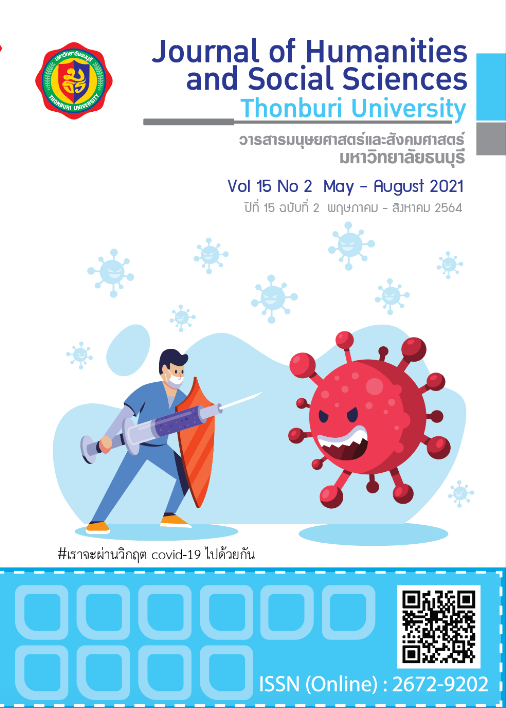ความสัมพันธ์ระหว่างบทบาทภาวะผู้นำเชิงกลยุทธ์ นวัตกรรมผลิตภัณฑ์ และพันธมิตรทางธุรกิจที่มีผลกระทบต่อความได้เปรียบในการแข่งขันของวิสาหกิจขนาดกลางและขนาดย่อมในเขตภาคเหนือตอนบน
Main Article Content
บทคัดย่อ
งานวิจัยนี้มีวัตถุประสงค์ 1) เพื่อศึกษาบทบาทภาวะผู้นำเชิงกลยุทธ์ นวัตกรรมผลิตภัณฑ์ พันธมิตรทางธุรกิจและความได้เปรียบในการแข่งขันของ SMEs 2) เพื่อศึกษาความสัมพันธ์ระหว่างบทบาทภาวะผู้นำเชิงกลยุทธ์ นวัตกรรมผลิตภัณฑ์ และพันธมิตรทางธุรกิจที่มีผลกระทบต่อความได้เปรียบทางการแข่งขันของ SMEs กลุ่มตัวอย่างคือผู้ประกอบการ SMEs ในเขตเชียงใหม่ ลำปาง ลำพูน แม่ฮ่องสอนจำนวน 325 ราย ใช้สถิติอนุมานวิเคราะห์ด้วยสมการโครงสร้างเพื่อหาความสัมพันธ์ของตัวแปรทางตรงและทางอ้อม ผลการวิจัยพบว่าโมเดลมีความสอดคล้องกับข้อมูลเชิงประจักษ์ของ SMEs อยู่ในเกณฑ์ดี โดยมีความคิดเห็นต่อบทบาทภาวะผู้นำเชิงกลยุทธ์มากที่สุด รองลงมา คือ พันธมิตรทางธุรกิจ ความได้เปรียบในการแข่งขัน และนวัตกรรมผลิตภัณฑ์ ปัจจัยที่มีความสัมพันธ์พบว่า 1) บทบาทผู้นำเชิงกลยุทธ์มีผลกระทบต่อนวัตกรรมผลิตภัณฑ์ พันธมิตรทางธุรกิจ และความได้เปรียบทางการแข่งขัน 2) นวัตกรรมผลิตภัณฑ์มีผลกระทบต่อพันธมิตรทางธุรกิจ และความได้เปรียบทางการแข่งขัน 3) พันธมิตรทางธุรกิจมีผลกระทบต่อความได้เปรียบทางการแข่งขัน สรุปได้ว่าทุกตัวแปรที่ไม่เกิดปัญหาการมีความสัมพันธ์ระหว่างกันสูงเกินไป ผลการวิเคราะห์องค์ประกอบเชิงสำรวจ ตัวแปรแต่ละกลุ่มมีน้ำหนักองค์ประกอบสูง มีค่าความผันแปรที่สกัดใกล้เคียงและมีความเชื่อถือได้สูง
Article Details
References
กีรติ ยศยิ่งยง. (2552). องค์กรแห่งนวัตกรรม แนวคิดและกระบวนการ. กรุงเทพฯ: สำนักพิมพ์แห่งจุฬาลงกรณ์มหาวิทยาลัย.
ผุสดี ชุ่มดวง. นายกสมาคมเครือข่ายที่ปรึกษาภาคเหนือ. 12 กุมภาพันธ์ 2560. สัมภาษณ์.
สมนึก เอื้อจิระพงศ์พันธ์. (2553). รูปแบบการพัฒนาความสามารถในการจัดการความรู้ของผู้ประกอบการที่มีนวัตกรรมในประเทศไทย ปริญญาวิทยาศาสตร์ดุษฎีบัณฑิต สาขาวิชา ธุรกิจเทคโนโลยีและการจัดการนวัตกรรม (สหสาขาวิชา) บัณฑิตวิทยาลัย จุฬาลงกรณ์มหาวิทยาลัย.
สำนักงานเลขาธิการสภาผู้แทนราษฎร. สำนักวิชาการ. นวัตกรรมก้าวใหม่ SMEs สู่ธุรกิจยั่งยืน. สืบค้นเมื่อ 15 มกราคม 2560, จาก https://library2.parliament.go.th/ejournal/content_af/2558/sep2558-2.pdf
สำนักงานส่งเสริมวิสาหกิจขนาดกลางและขนาดย่อม. (2558). รายงานสถานการณ์วิสาหกิจขนาดกลางและขนาดย่อม ปี 2557 และแนวโน้มปี 2558. กรุงเทพฯ: สำนักฯ.
สำนักงานส่งเสริมวิสาหกิจขนาดกลางและขนาดย่อม. (2559). แผนการส่งเสริมวิสาหกิจขนาดกลางและขนาดย่อม ฉบับที่ 4 (พ.ศ.2560-2564). กรุงเทพฯ: สำนักฯ.
Adair, J. (2010). Strategic Leadership: How to Think and Plan Strategically and Provide Direction (The John Adair Leadership Library). London: Kogan Page.
Akio, T. (2005). The critical assessment of the resource-based view of strategic management: The source of heterogeneity of the firm. Ritsumeikan International Affairs. 3(1).
Barney, J. B. (1991). Firm resources and sustained competitive advantage. Journal of Management. 17(1): 99-120.
Cannella, B., Finkelstein, S ., & Hambrick, D.C. (2008). Strategic Leadership: theory and Research on Executive, Top Management Teams, and Board.
Cefis, E. , & Marsili, O. (2005). 'A Matter of Life and Death: Innovation and Firm Survival.' Industrial and Corporate Change. 14(6), 1-26.
Comrey, A.L., & Lee. H. B. (1992). A First Course in Factor Analysis. New Jersey: Erlbaum.
Farinda, A. G., Kamarrulzaman, Y., & Abdullah, A. (2009). Building business networking: A Proposed Framework for Malaysian SMEs. International Review of Business Research Papers. 5(2): 151-160.
Feng, T., Sun, L., & Zhang, Y. (2010). The effects of customer and supplier involvement on competitive advantage: An empirical study in China. Industrial Marketing Management. 39(8): 1384–1394.
Floyd, Gloria J. (2011). Fifteen Qualities For Strategic Nursing Leadership. Retrieved June 12, 2011, from http://www. nurseRecruiter.com/.../strategic_nursing_lead...
James L. Arbuckle. (2013). IBM SPSS Amos 22 User’s Guide. U.S.A.: IBM Corporation.
Kanter, R.M. (1985). Supporting Innovation and Venture Development in Established Companies. Journal of Business Venturing. 1: 47-60.
Kusumawardhani, A., McCarthy, G. & Perera, N. (2009). Framework of entrepreneurial Orientation and networking: a study of SMEs performance in a developing country. Proceedings of the Australian and New Zealand Academy of Management Conference, 1-16. Adelaide, Australia: Australian and New Zealand Academy of Management.
Lee, C. W. (2007). Strategic alliance influence on small and medium firm performance. Journal of Business Research. 60: 731-741.
Likert, R .N. (1970). “A Technique for the Measurement of Attitude”. Attitude Measurement. Chicago: Ronald McNally & Company.
Mazzarol, T., Volery, T., Doss, N., & Thein, V. (1999). Factors influencing Small businesse start-ups. International Journal of Small business managerial Behaviour and Research. 5(2): 48-130.
McKeown, N., Anderson, T., Balakrishnan, H., Parulkar, G., Peterson, L., Rexford, J., & Turner, J. (2008). OpenFlow: enabling innovation in campus networks. ACM SIGCOMM Computer Communication Review. 38(2): 69-74.
Mohd R. M. (2012). Competitive strategy of Malaysian small and medium enterprises: An exploratory investigation. American International Journal of Contemporary Research. 2(1): 285-298.
Morrill, R.L. (2010). Strategic Leadership: Integrating Strategy and Leadership in Colleges and Universities. Maryland: Rowman & Littlefield Publisher, Inc.
Peppard, J. and Rylander, A. (2006). From Value Chain to Value Network: Insights for Mobile Operators. European Management Journal. 24: 128–41.
Porter M. E. (1985). M. E. (1985). Competitive Strategy: Techniques for Analyzing Industries and Competitors, New York, NY: The Free Press.
Rothwell, R. (1992). Successful Industrial Innovation: Critical Factors for the 1990s.RandD Management. 22: 221–239.
Schumpeter, J. A. (1950). Capitalism, Socialism and Democracy. 3rded. New York: Harper and Row.
Street, C. T., & Cameron, Ann-Frances. (2007). External relationships and the small business: A review of small business alliance and networking research. Journal of Small Business Management. 45(2): 239-266.
Suvi Konsti-Laakso, Timo Pihkala & Sascha Kraus (2012). Facilitating SME Innovation Capability Through Business Networking.
Wittmann, C. M., Hunt, S.D., & Arnett. D. B. (2009). Explaining alliance success: Competences, resources. Relational factors, and resource-advantage theory. Industrial Marketing Management. 38(7): 743-756.
Zeng, S. X., Xie, X. M., & Tam, C. M. (2010). Relationship between cooperation networks and innovation performance of SMEs. Technovation. 30(30): 181-194.
Ziggers, G. W., & Tjemkes, B. (2010). Dynamics in inter-firm collaboration: The impact of Alliance Capabilities on Performance. International Journal Food System Dynamics. 2: 151-166.
Translated Thai References
Chumduang, P. President of the Northern Advisory Network Association. 12 February 2017. Interview.
Euajirapongpan, S. (2010). Development model of knowledge management capacity of innovative entrepreneurs in Thailand. Doctor of Philosophy Program in Business, Technology and Innovation Management (Interdisciplinary) Graduate School Chulalongkorn University. (in Thai)
Office of Small and Medium Enterprises Promotion. (2015). Report on Small and Medium Enterprises in 2014 and Trends for 2515. Bangkok: Office of Small and Medium Enterprises Promotion. (in Thai)
Office of Small and Medium Enterprises Promotion. (2016). Small and Medium Enterprises Promotion Plan No. 4 (2017-2021) Bangkok: Office of Small and Medium Enterprises Promotion. (in Thai)
The Secretariat of the House of Representatives Academic Office. Innovation a new step towards SMEs towards sustainable business. Retrieved January 15, 2017, from https://library2.parliament.go.th/ejournal/content_ af/2015/sep2015-2.pdf (in Thai)
Yodyingyong, K. (2009). Innovation organizations. Concepts and processes. Bangkok: Chulalongkorn University Press. (in Thai)

